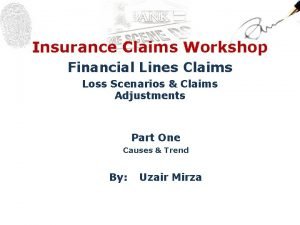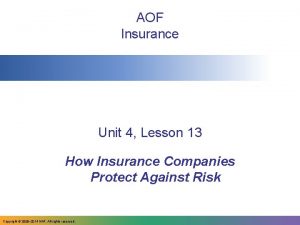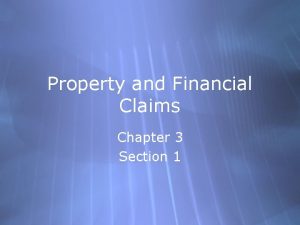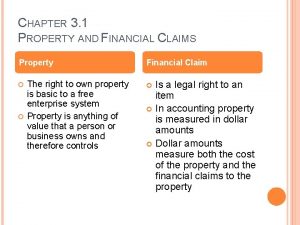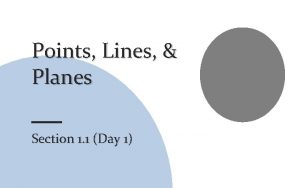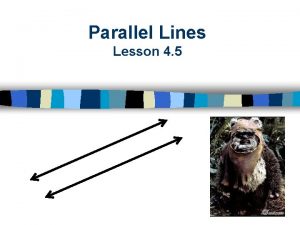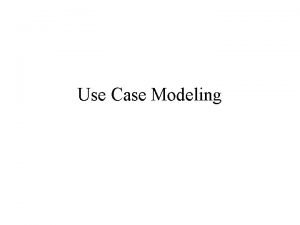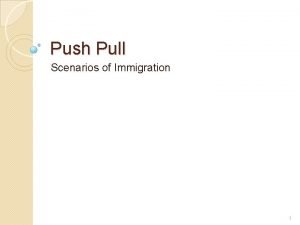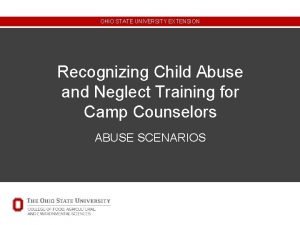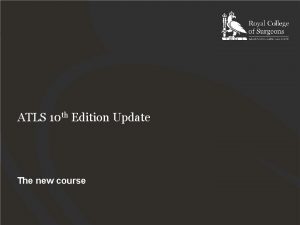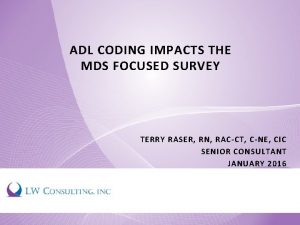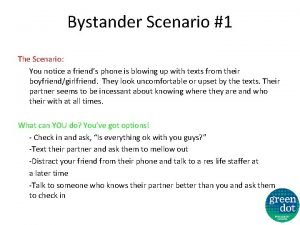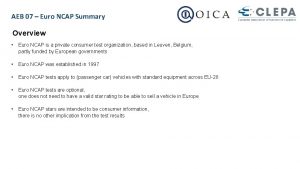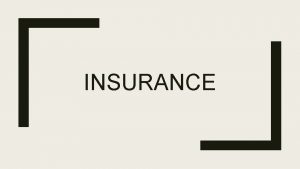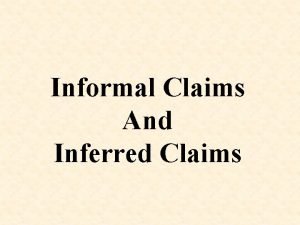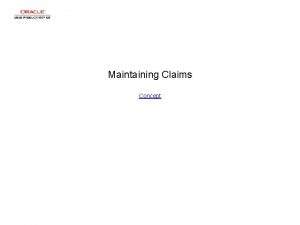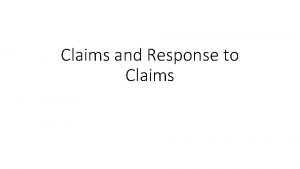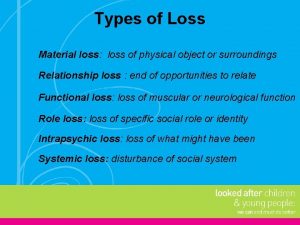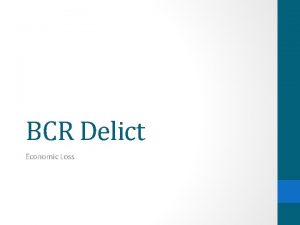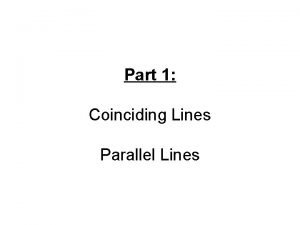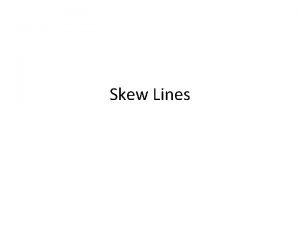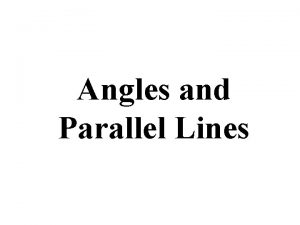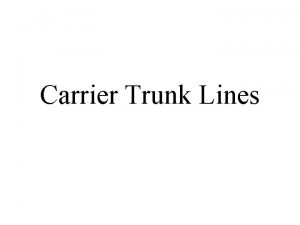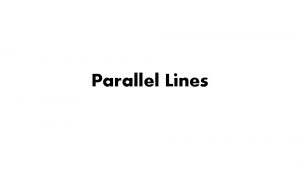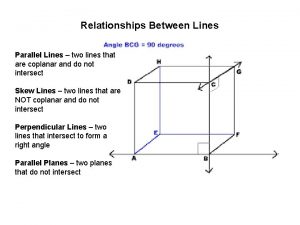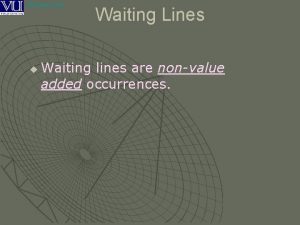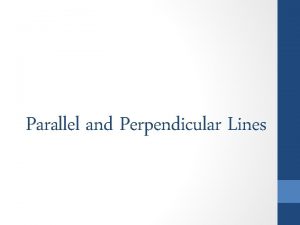Insurance Claims Workshop Financial Lines Claims Loss Scenarios
























































- Slides: 56

Insurance Claims Workshop Financial Lines Claims Loss Scenarios & Claims Adjustments Part One Causes & Trend By: Uzair Mirza

Crime • Financial Institutions particularly banks are exposed to a variety of crimes ranging from very crude holdups/robberies to complex frauds and forgeries • Result – Financial Loss, Litigations, Bad Press etc.

Crude Crime • Robberies • Hold-ups (Dacoity) • Theft • Generally Violent • Single Attempt • Immediately known • Think

Complex Crimes • • • Counterfeiting Forgery Embezzlement Computer Fraud Plastic Card Frauds • Non-Violent • Multiple Attempts • Generally Not Immediately Known • Think

Key Difference • Crude Crime – Loss quantum is known immediately with certainty • Complex (White Collar) Crimes – establishing Loss quantum is not easy and time consuming; generally speaking

Types of Crime – Crude / Violent Crimes • Small amounts (few thousand rupees) to very large bank heists involving hundreds of millions rupees. • During Business Hours • Off Business Hours • Simple show of weapon to actual shooting spree • Couple of minutes to overnight stay in bank premises • Totally fortuitous without any inside assistance and/or information • Insider’s initiated and/or assisted assault

Types of Crime – Complex Crimes • Rarely involve small amounts; generally bigger than average robbery claim • Generally perpetrated by an insider (Employee) alone or in connivance with an outsider • Not very often also by someone well versed with “loop holes” in internal control if not assisted or connived by an insider • Generally multiple incidents where an employee or a well versed outsider involved • Most common cause of third party fraud is breach of So. Ps and guidelines

Key Factors MACRO Both type of Crimes have roots in – Condition of Economy – Political / Law & Order Situation MICRO – Branch Network – Physical Security – Operational Controls

Macro Factors • Criminologists tend to say that tough economic times lead to more property crimes and robberies. • Economists tend to argue the opposite, that better economic times increase crime. • Both Correct

Both Correct • Crude and violent Crime generally on the rise during the periods of economic distress coupled with political instability and deteriorated law and order • Incidents of Frauds and forgeries increase during periods economic growth but notthat-effective law enforcement

Macro Factors • Crime is episodic and there is no singular effect of the economy on crime. It is necessary to understand what type of period we are in. • The presence of gangs, weapons availability, the availability and level of protection of potential targets etc. , and the effectiveness of law enforcement activity all play a significant role in enabling or restraining overall crime levels.

Macro Factors • Further criminological factors such as – shift from ‘traditional’ property crimes to new types of acquisitive crime such as computer fraud, – the impact of government policy aimed at reducing crime. – complex interplay of gradually changing socioeconomic factors.

Macro Factors • There is a lag time between changes in the economic variable and resultant impact on crime levels. The average lag time could vary from couple of months to years.

Micro Factors – Branch Network Financial Institutions with extended branch networks are more exposed to violent crimes and frauds – Physical Security Less Security – More Chances of Crime – Operational Controls Most Important in restraining Frauds and Complex Crimes

Internal Control • The word CRIME is an acronym for internal control components: – Control • • Policies and procedures proper segregation of duties, safeguarded computer systems, proper review and approval process etc. – Risk • periodic identification and assessment of risk arising from both internal and external sources, • Formulation and implementation of processes to minimize identified risks.

Internal Control – Information Systems • procedures for capturing and communicating critical data effectively to designated employees, • ensuring good password and other computer security processes • authorization procedures, etc. – Monitoring • continual process of evaluating, assessing and updating the systems of internal controls for ensuring consistent application of procedures. – Environment • corporate culture setting and promoting a zero tolerance policy for abused or misused internal controls.

Pakistan Economic Growth

Pakistan Unemployment Rate

Average Loss Size - Crude Crime 6, 000 5, 000 4, 000 3, 000 2, 000 1, 000 0 2006 2008 2010 2012 2014 2016 2018

Average Loss Size - Employee Fraud 10, 000 9, 000 8, 000 7, 000 6, 000 5, 000 4, 000 3, 000 2, 000 1, 000 0 2006 2008 2010 2012 2014 2016 2018

Average Loss Size - Other Frauds 2, 500, 000 2, 000 1, 500, 000 1, 000 500, 000 0 2006 2008 2010 2012 2014 2016 2018

Average Loss Size - All Types Average Loss Size - All Losses 7, 000 6, 000 5, 000 4, 000 3, 000 2, 000 1, 000 0 2006 2008 2010 2012 2014 2016 2018

Year Wise Number of Incidents Composition 70% 60% 50% 40% Number of Crude Number of Employee 30% Number of Other 20% 10% 0% 2006 2008 2010 2012 2014 2016 2018

Year Wise Loss Amount Composition 100% 90% 80% 70% 60% Amount Crude 50% Amount Employee Amount Other 40% 30% 20% 10% 0% 2006 2008 2010 2012 2014 2016 2018


Financial Lines PART 2: CONTINUED BY: KHURRAM NASIM GHUMAN

Financial Lines “Financial Lines” stands for insurance products covering financial loss and costs thereof. Financial Loss means loss which is neither personal nor property damage nor derived from such damages.

Current Active Financial Lines Products Here 1. Bankers Blanket Bond 2. Electronic & Computer Crime Insurance 3. Lockers Insurance ~ Banks’ Legal Liability Cover 4. Plastic Card Insurance 5. Financial Institution Professional Indemnity Insurance 6. D&O Liability Insurance

Insurance Offerings The insurance market offers various policies, on named perils basis, and has demonstrated willingness to innovate and add new policies in line with the changing needs of Financial Institutions BBB ECC SDB FIPI D&O

Financial Lines Products First party loss (direct financial loss sustained by the policyholder)

Losses Discovered / Claims Made Direct Financial Loss: Discovered or First Made during policy period AND Sustained after the Retroactive Date Policy responds to the date of Discovery and not date of Occurrence

What is at Risk? PROPERTY • Cash • Bullion, Precious metals, Stones gems etc. • Cheques, Payorders, DD • Share Certificates, Title Deeds, Bonds etc. , • Electronic & Computer Fund Transfer Instructions, • Electronic Securities • Customer Property in Safe Deposit Lockers

Who Can Risk the Property? • Insiders • • Dishonest Employees Outsiders • Robbers, • Burglars, • Thieves, • False Pretenders • Fraudsters etc. ,

Operative Clause Promise to make good • Direct Financial Loss • In excess of Deductibles • Subject to Terms and Conditions • Discovered During the Policy Period • Occurred Subsequent to Retroactive Date

Why Do You Need BBB Insurance? Crime is a global problem and is often an unfortunate “by product” of social advancement. Crime is on the increase everywhere in the world and the sad fact is that many Banks/Financial Institutions have only become alerted to this as a result of a crime loss. Because of today’s economic climate there has been a surge in armed bank raids, fraudulent transfer of funds by employees, theft of cash by employees, raids on cash in transit and increased document fraud. EVERY FINANCIAL INSTITUTION IS VULNERABLE !

BBB Policy Composition Infidelity Of Employees Premises Risk Transit Risk Forgery Counterfeit Currency Office & Contents Securities

MAIN BBB INSURING CLAUSES 1. Infidelity Dishonest or fraudulent acts of Employees 2. On Premises Loss or Damage to cash and securities. 3. In Transit Loss or damage to cash an securities in transit 4. Forgery or Alteration Loss resulting from forgery or fraudulent alteration of banking collateral instruments; cheques, drafts, bills of exchange etc. 5. Securities Loss resulting from the Assured acting in good faith upon Securities which prove to be counterfeit, Forged or Lost or Stolen

Conditions Precedent To Liability 1. A written and maintained Rule book of the business 2. Duty bifurcation from commencement to completion between employees 3. Joint Custody 4. Dual Control 5. Two weeks uninterrupted holiday in a calendar year 6. Thorough internal audit 7. Review of internal controls

Some Important Conditions 1. Merger or Change in Ownership or Control of Business 2. Other such Insurance in place 3. Sectional or Total aggregation of limit 4. Non-Cumulative Liability 5. Deductible/Excess 6. Ultimate Net Loss

LIMITS & DEDUCTIBLES Ø Insurance Premium Budget Ø Confidence in Risk Management & Control Process Ø Areas of Business Activity Ø Geographical Spread Ø Appetite for Risk Ø Loss History Ø Peer Group Limits Ø Availability of the Limit Ø Size of the Institution

INTERNATIONAL CAPACITY Capacity Others; 7% Swiss; 6% UK (Cos); 38% USA; 27% UK (Lloyds); 22% UK (Cos) UK (Lloyds) USA Swiss Others

UNDERWRITING CONCERNS FOR INSURERS 1. Loss history 2. Financial Status of the Bank 3. Compliance 4. Underwriting values at risk 5. Procedures & Controls 6. Physical Security 7. General description of data processing activities 8. Details of computer hardware and software 9. Details of systems, independent contractors, fund transfers and clearing operations 10. Thorough Risk Review

Limits/Sub-limits & Deductibles • Overall Policy Aggregate • BBB • Section Aggregate Sub Limit • Individual Clause wise Sub Limits & Deductibles • Branch Wise Sub Limits & Deductibles • Computer Crime • Section Aggregate Sub Limit • Individual Clause wise Sub Limits & Deductibles • Lockers • Section Per Event & Aggregate Sub Limit • Locker Size Wise Per Event Limit

Few Loss Examples Branch manager at a bank over a number of years embezzled from long term deposit accounts of elderly customers. Total figure USD 15 m A manager at a bank used her position within the branch to set up accounts using false names and granted loans and over-drafts to them. She also embezzled from genuine customers’ accounts, by changing personal details and sending new cards / cheque books to false addresses. Total figure USD 1 m Bank employee fraudulently transferred monies from 11 dormant accounts to offshore accounts. All traces of the accounts were wiped out to cover her tracks. Total figure USD 4. 3 m

Loss Examples continued… A commercial bank issued unsecured personal loans to customers on the basis of Salary Certificates and 3 months of Bank Statements. The bank began to review their loan files after a number of loan defaults and discovered that they had acted upon forged Salary Certificate letters for individuals that were not employees of the company purporting to issue the letters as well as falsified Bank Statements. The loan process had proven to be weak and no actual verification of the Salary Certificates had been conducted leaving the bank with a significant financial loss. Total figure USD 1. 75 m

Loss Examples continued… A bank became the target of a well organised criminal group who managed to obtain forged passports for several account holders, as well as duplicated mobile telephone SIM cards. This enabled the criminals to change sensitive account information including call-back verification numbers and then make fraudulent withdrawals from customer accounts. Total figure USD 1. 34 m

Loss Examples continued… A Bank had its Credit Card systems hacked by a fraud gang. The cards were all Pre-Paid Credit Cards. Once the banks’ systems were amended the fraud gang used the cards to withdraw money via various ATM machines around the world. In a 24 hour period the bank had lost in excess of USD 40 m. Other banks have also been targeted, using a similar means to get in to the banks systems which have resulted in further losses of around USD 5 m. It come to light that the hackers amended the card limits and security coding which allowed the gang to get away with these large sums of money without the standard security measures being activated. Total figure USD 45 m

Add on Cover Computer Crime: Added on to a Banker's Blanket Bond Policy, Computer Crime Insurance attempts to provide, under one insurance contract, protection for “electronic funds” against Crime Risks perpetrated by unidentified employees or other persons through the Banks/Financial Institutions computer system(s).

Electronic & Computer Crime Financial Institutions have an Increasing reliance on automated systems, which led insurers to re-examine coverage and develop Electronic & Computer Crime insurance as a companion to BBB. Whilst the Bankers‘ Blanket Bond would cover losses associated with employee fraud in the bank's automated systems, it would not cover fraud perpetrated by third parties using telecommunications links connected to the computer systems

Computer Crime Insuring Clauses (LSW 238) • • • Clause – 1 (Computer Systems) Clause – 2 (Assured Service Bureau Operations) Clause – 3 (Electronic Computer Instructions) Clause – 4 (Electronic Data & Media) Clause – 5 (Computer Virus) Clause – 6 (Electronic Communication) Clause – 7 (Electronic Transmission) Clause – 8 (Electronic Securities) Clause – 9 (Electronic Telefacimile) Clause – 10(Voice Initiated Transfers)

Professional Indemnity Insurance Protection to the institution for the legal liability to third parties for compensatory damages, claimant costs and expenses arising out of negligent acts, errors or omissions. Activity with Significant Exposures include: 1. Corporate Finance: Mergers and Acquisitions 2. Trade Finance: Letters of Credit 3. Financial Advice 4. Asset Management 5. Stock Broking

Safe Deposit Lockers (NMA 1790) • Customer Property (of intrinsic value) placed inside Lockers (inside a secured and guarded premises) • Excluding Cash and items with no commercial value

Cyber Risk (An Emerging Topic) Cyber risk now ranks as one of the top enterprise wide risks facing organisations today. Cyber-attacks, operational errors or technical failures have the ability to paralyse an organisation leading to significant financial loss, regulatory issues and lasting reputational damage.

Response To Cyber Risk CYBER INSURANCE Cyber liability insurance policies have been developed to address the first and third party impacts which can result from a cyber-incident whether malicious or accidental. Traditional insurance policies may not respond to these new risks. They were developed to protect against physical triggers (e. g. fire, explosion, theft, flood etc. ) leading to physical outcomes (e. g. property damage, bodily injury) rather than data, networks and intangible assets.

SCOPE OF CYBER INSURANCE 1. Personal data liability 2. Corporate data liability 3. Outsourcing liability 4. Data security liability 5. Data administrative investigations 6. Data administrative fines 7. Repair of the company’s reputation 8. Defence costs 9. Media content 10. Network interruption.

THANK YOU
 Financial lines insurance examples
Financial lines insurance examples Normal loss treatment in process costing
Normal loss treatment in process costing Insurance loss assessor leicester
Insurance loss assessor leicester Fire insurance introduction
Fire insurance introduction Insurance claims stock
Insurance claims stock You should not open a persuasive request with a question.
You should not open a persuasive request with a question. Chapter 10 financial planning with life insurance
Chapter 10 financial planning with life insurance Www.primericasecure/business
Www.primericasecure/business Unit 2 lesson 3 health insurance and financial planning
Unit 2 lesson 3 health insurance and financial planning Unit 2 lesson 3 health insurance and financial planning
Unit 2 lesson 3 health insurance and financial planning Financial claims
Financial claims Claim assets
Claim assets Non financial methods of motivation
Non financial methods of motivation Worksheet 1-1 points, lines, and planes day 1
Worksheet 1-1 points, lines, and planes day 1 Skew line def
Skew line def Kraissl lines vs langer lines
Kraissl lines vs langer lines Lines are lines that never touch and are coplanar.
Lines are lines that never touch and are coplanar. Line conventions in engineering drawing
Line conventions in engineering drawing Horizontal line art definition
Horizontal line art definition Def of parallel lines
Def of parallel lines Workplace etiquette worksheet
Workplace etiquette worksheet Good hazard scenarios describe where it is happening
Good hazard scenarios describe where it is happening What is a use case scenario
What is a use case scenario Examples of problem solving scenarios for adults
Examples of problem solving scenarios for adults Scene size-up scenarios
Scene size-up scenarios Push and pull scenarios
Push and pull scenarios Personal safety activities
Personal safety activities Refusal skills role play scenarios
Refusal skills role play scenarios Patient scenarios examples
Patient scenarios examples Pc hpc pmh dh
Pc hpc pmh dh Child abuse scenarios
Child abuse scenarios Lgbtq scenarios
Lgbtq scenarios Healthy and unhealthy relationships scenarios
Healthy and unhealthy relationships scenarios Example of a win win situation
Example of a win win situation Win-lose attitude
Win-lose attitude Oecd scenarios for the future of schooling
Oecd scenarios for the future of schooling Difficult conversation role play scenarios
Difficult conversation role play scenarios Cyber bullying scenarios
Cyber bullying scenarios Computer ethics case scenarios
Computer ethics case scenarios Atls moulage scenarios
Atls moulage scenarios Adl coding scenarios
Adl coding scenarios Budget scenarios activity
Budget scenarios activity The deadly picnic lab who killed mr. brooks answers
The deadly picnic lab who killed mr. brooks answers Application of piecewise functions in real life
Application of piecewise functions in real life What would you do scenarios for students
What would you do scenarios for students Alan cooper personas
Alan cooper personas Challenging behaviour scenarios
Challenging behaviour scenarios Totaps example
Totaps example Deca role play scenarios
Deca role play scenarios Deca roleplay rubric
Deca roleplay rubric Communication scenarios
Communication scenarios Bystander scenarios
Bystander scenarios Aeb ncap
Aeb ncap Quality attributes scenarios
Quality attributes scenarios Dom scenarios
Dom scenarios Scenario examples
Scenario examples Permissive parenting
Permissive parenting
